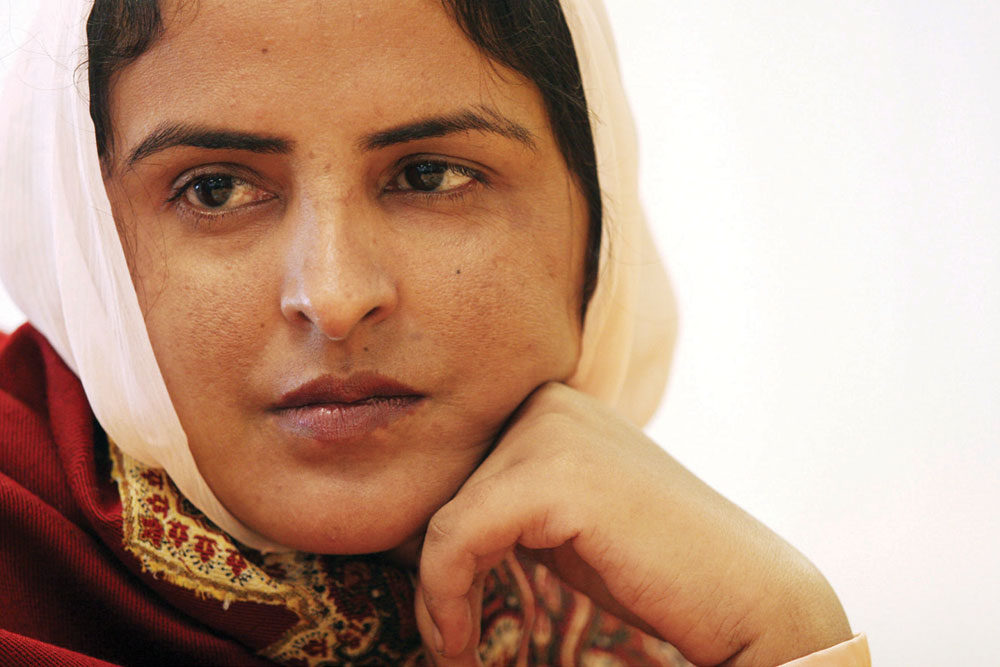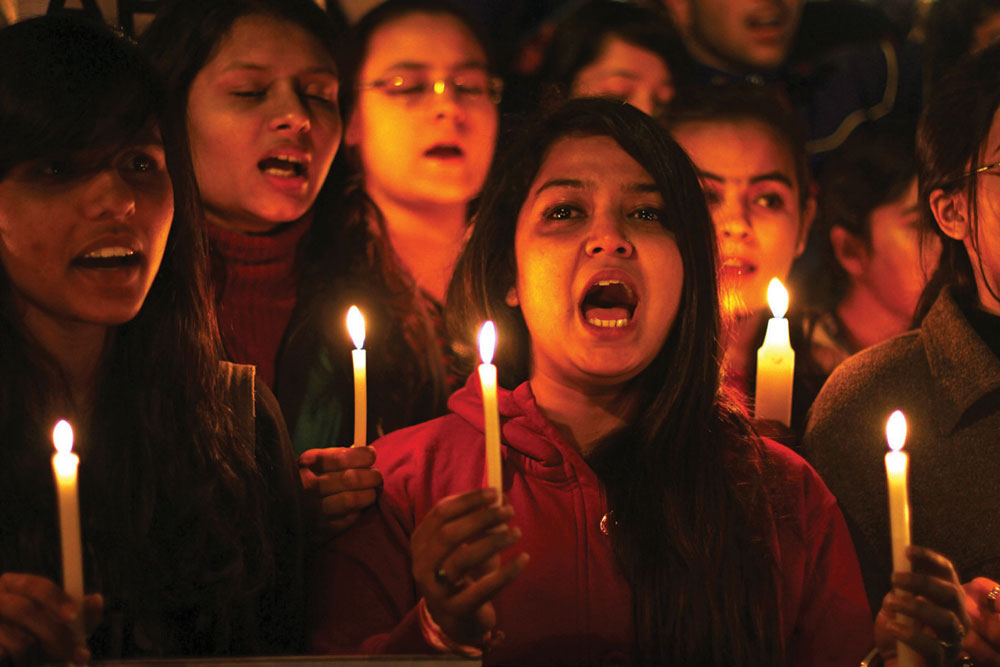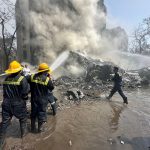Not In My Name
Vigilantism is not a substitute for justice
 Mehr Tarar
Mehr Tarar
 Mehr Tarar
Mehr Tarar
 |
13 Dec, 2019
|
13 Dec, 2019
/wp-content/uploads/2019/12/Notinmyname.jpg)
(L-R): Scenes from Insaf Ka Tarazu, Simmba and The Accused
WHEN I WAS IN HIGH SCHOOL, there was one banned item on the list of films for my cousins and me: Insaf Ka Tarazu. Although the name wasn’t risqué, we were told that while we could watch Maang Bharo Sajana, the story of a man who has a wife and a mistress who dies waiting for her maang (hair partition) to be bharo’ed (filled), as many times as we liked, the content in Insaf Ka Tarazu was something beyond our age. It was.
What no one said was that it was about things that should never, ever happen to any woman. It was banned simply because of its more explicit depiction of rape than in most movies in which the woman lost her ‘izzat’, honour. Insaf Ka Tarazu became another addition to not-to-be-watched things. It was not in the box of what a human being must never, ever do. No one talked about that.
Children are taught what to watch, what is good, what must never be done. Some children break the rules, watch the forbidden films, read the forbidden books, grow up to cross into forbidden borders, love the forbidden person. They never mean to hurt, they never intend to cause pain. Some children grow up to be everything that is bad. No one teaches a child to do bad things. It is just that as adults they forget what it is like to be kind, to not take what is not theirs, to not have mindless anger towards a human being who never did anything bad to them, to not inflict emotional harm, to not unleash physical violence on a weaker being.
Rape is not about sex. Rape is about the need to feel powerful, about forgotten humanity, about crossing a line that must never, ever be crossed, about causing pain that is so intrinsically human that it defies description. Rape is humanity losing its equilibrium. Rape is about human beings doing things that are construed to be animal. It is just that animals don’t rape. Only human beings do.
I don’t know why people do what they do. All I know is they do what they do, and the world becomes crueler, bleaker, emptier. I’m not writing to understand why people rape and murder their victims. I’m trying to see how the pursuit of justice for rape is not merely the R-Rated content of films that have been a global constant for decades; it is also a weary depiction of reality that is too uncomfortable, too dark to ever have a plausible explanation. Rape, like any other crime, seeks justice. Murder, kidnapping, torture, robbery, extortion, blackmail, violence, war crimes, all need justice, in varying degrees.
All films that are based on the idea of justice for a crime to an individual, a community, a city, a race, a faith, a country, work on the principle of vigilantism, of taking the matter in your hands, of giving up on the system, of not trusting the system, of the inability to take one more injustice without resistance, of banishing the ideal that justice is a fundamental right, not a luxury.
All films that are based on the idea of justice for a crime to an individual, a community, a city, a race, a faith, a country, work on the principle of vigilantism
In 1980’s Insaf Ka Tarazu, Zeenat Aman’s Bharati does what is written in the handbook for rape victims. She calls the police, reports the rape and fights her case in court. Nothing happens. Demeaned, slut-shamed, mocked, she loses the case. Her rapist walks away with a smirk, and returns two years later to rape her younger sister. Bharati kills the man who had raped her and her sister. Her words to the judge ‘khoon kya hai magar jurm nahin kya’ set the theme of every movie on vengeance.
In Simmba in 2019, the same theme is replicated packaged with more swagger, with more lack of confidence in the system. Movies don’t teach what to do and what not to do. Movies show what is. Some indulge in patronisation of the bad, some in glorification of the undesirable, some in self-righteous pontification. What is the intention of none: teaching the world to do bad. From Insaf Ka Tarazu, literally meaning scales of justice, to Simmba, the lone crusader played by the brilliant Ranveer Singh, there is one overarching message: the world is an increasingly cruel and a dark place.
Vigilante justice, police ‘encounters’ and extrajudicial killings exist on celluloid. Spilling from the screen they blur into the actions of real people—those who are hurt, those who watch their loved ones bleed, those who watch death become the comforting refuge of those who seek justice, those who could not provide justice. Vigilantism does not heal. Vigilantism does not stop the pain. Vigilantism of those who take the law in their own hands is an unsteady step into societal disarray that is already on the verge of implosion.
Vigilantism of those who swear to protect in uniform is a loud discharge of an official weapon to announce their incapability to do the right thing the right way. Vigilantism to kill in a police station cell the rapist and murderer of a child is a delayed, tepid self-assertion of keeping the world safe for its young and the vulnerable. Vigilantism to kill four young suspects from an under-privileged background who are accused of rape and murder most foul of a young woman is an enraged expostulation of reordering the world in controllable cohesion.

Vigilantism makes Simmba a hero, vigilantism does not make the world a safer place. What it does is, sometimes, it becomes a wake-up call. It is one act of violence to avenge another act of violence showing in all its gory starkness the imperativeness to fix the system. Things don’t change in police stations, in courts. Things change when a society has the realisation of a collective rot, and the impotence of individual efforts. The home is the first school, it is the parents who teach their children the value of kindness, of humanity. The rest of the world joins later.
When children are gang-raped and murdered, and young women are raped, murdered and burnt, the collective conscience of a society is shaken to its core. To do more, to do better, to do it on time, to do it without being told. Doing the right thing should be a reflex, not an afterthought. Acting on time to help is not a forgotten Boy Scout lesson; it is humanity 101. Empathy is not a seven-letter delicacy meant to be used in cautious reluctance; it is the humanness that makes it impossible to look away from someone else’s pain. Doing your duty in a police station and a court is not heroism; it is a simple reiteration of the sanctity of the oath that you took to serve, and to serve without distinction of class, gender, caste, faith, financial background, ethnicity and nationality.
A society that is not a silent spectator of cruelty and injustice does not applaud vigilantism. Cruelty and injustice do not happen in a vacuum. Individuals with their ghastly deeds do not destroy the moral fibre of a society. It is the interconnected factors of collective apathy that acts as a dehumanisation mechanism to unleash a dystopia in which children are gang-raped, women’s bodies are used as a retributive tool to humiliate a family, young women are raped and murdered and burnt, young women are watched without any effort to help as they self-immolate after being raped, young women are raped and set on fire when they seek justice. Mob justice is a short-lived antidote for a metastasised cancer, without any thought, without any self-reflection. Nothing will change until the entire society engages in introspection and says out loud: no more.
In front of hundred of people, she was dragged into a house and raped by four men. Her father and uncle, restrained by spectators, heard her screams and begged for mercy. No one helped Mukhtar Bibi
After my Bachelor’s, as I was wondering what to do with my life with choices that I could count on my left middle finger, I watched The Accused in 1988. I watched it again in 2018. What I felt both times, as a twenty-year-old and a fifty-year-old woman, was identical. Women are raped in every country of the world, and the pursuit of justice for rape is another desecration of the body, the mind, the soul. The Accused is one of those rare movies where justice is done in a court of law, in joyous affirmation of the power of the victim to be a strong survivor with the help of a lawyer who believes in the power of the law to do the right thing, even when it seems unfair, even when it takes long.
As I think about the women in Insaf Ka Tarazu and The Accused, my mind wanders to stories of girls and women who lived amongst us, and were raped and killed. Those who weren’t killed were made to live wishing they were dead. Those who dared to speak up paid a price. Those who fought for justice were killed. Humanity watched. Humanity did not intervene. Their stories become temporary grief for a crime-hardened society until the next one, the more horrendous one replaced it in television headlines, candlelight vigils of crying protesters, strident condemnation of activists and lawyers on talk show panels, chest-thumping declarations of politicians, new and stricter laws of parliamentarians, and vows of law enforcers to stop crimes. The brief trauma before it shifts to the next tragedy.
Then there are those that haunt for a long time. They haunt my humanity.
On June 22nd, 2002, Mukhtar Bibi, also known to Pakistan and the world as Mukhtaran Mai, was raped in her village Meerwala, district Muzaffargarh, Punjab, Pakistan. Four men raped her. Mukhtar Bibi, 28 then, was gang-raped for seeking mercy for her 12-year-old brother, Shakur, who had been accused of having an affair with a much older woman of a ‘higher’ tribe. Shakur was kidnapped, beaten, tortured and raped. And as cover-up, he was accused of the affair he was too young, too ‘unsuitable’ to have. Mukhtar Bibi, accompanied by her father and uncle, met a jirga ‘to apologise on behalf of her tribe and seek mercy for Shakur.’
She didn’t receive mercy. In front of hundreds of people, she was dragged into a house and raped by four men. Her father and uncle, restrained by spectators, heard her screams and begged for mercy. No one helped Mukhtar Bibi.
In a world where women were not more than disposable property of a patriarchal system, and rape is considered the destruction of the honour of a family, Mukhtar Bibi filed a case, and in July 2002, 14 men were arrested. Six were found guilty, ‘four of rape, two of ordering the rape; all six were sentenced to death.’
In March 2005, the Lahore High Court acquitted five, and changed the death sentence of the last one to life imprisonment. In June 2005, the Supreme Court, overturning the acquittals, ordered re-arrests of all 14 accused. In April 2011, the Supreme Court acquitted 13 and charged one. In June 2016, the Supreme Court ‘took the extraordinary decision to judicially review their 2011 verdict.’ In June 2013, the Supreme Court ‘dismissed a review appeal filed by Mukhtaran Mai against the acquittal of thirteen people accused in the gang-rape case.’
Mukhtar Bibi is now 47 years old. She is still waiting for justice.
On December 16th, 2012, the 23-year-old Jyoti Singh, known to India and the world as Nirbhaya, was brutally beaten, raped and thrown out of a bus in Delhi. As she lay almost unconscious, naked, broken, bleeding on the side of the road, her crying, hurt friend trying to keep her alive, Delhi walked by, Delhi drove by, without stopping. No one helped the young woman as she watched her broken body bleed, waiting to be rescued.

That and the police’s delayed response, debate about the jurisdiction of the crime and the shoddy transportation to hospital may not have been the reasons for worsening of Jyoti’s condition, but they depict in their apathetic horror the individual, collective, systemic and systematic callousness of a society that unites in grief but does not help individually.
Delhi grieved and prayed for Jyoti. All of India prayed.
Millions across the world prayed. I prayed in Lahore. Prayers and the best of medical treatment did not help a body whose insides were torn out with an iron rod. Jyoti Singh died on
December 29th, 2012.
Jyoti’s six rapists were apprehended, put on trial and sentenced. One, a juvenile, was given three years. One killed himself in jail. Four remain on death row.
On March 13th, 2014, an 18-year-old girl from Muzaffargarh, Punjab, Pakistan, set herself afire outside a police station. Allegedly raped in January, she was protesting the dropping of charges against her five rapists. People, including policemen, watched as the girl screamed in agony. No one helped her. Her younger brother who accompanied her in hope of justice was the only one who cared. That is when one policeman stepped in.
The teenager died in a hospital on March 14th, 2014. The then Chief Justice Tassaduq Hussain Jillani took suo motu notice, and ordered an investigation. Does posthumous justice bring any solace?
In January 2018, the news of the indescribable rape and murder of the eight-year-old Asifa Bano in Indian Kashmir shocked, grieved and angered India, and wherever the news was reported.
On January 10th, 2018, little Asifa, daughter of Muhammad Yusuf Pujwala, of the Gujjar community of Muslim nomadic shepherds, went missing in her village, Kathua. Her dead body was found five days later.
Police arrested eight men, ‘including a retired government official, four police officers and a juvenile.’ In June 2019, ‘an Indian court sentenced three men to life in prison for the abduction, rape and murder of an eight-year-old girl in a case that sparked a nationwide furore and inflamed tensions between Hindus and Muslims.’
The eight-year-old Asifa ‘had been tortured. Her legs were broken. Her nails had turned black and there were blue and red marks on her arms and fingers.’
According to the police, Asifa was kept in a local temple for a few days. She was given sedatives that kept her unconscious. The chargesheet stated that Asifa had been ‘raped for days, tortured and then finally murdered.’ Asifa was strangled to death. Her head was hit twice with a stone.
On January 5th, 2018, the six-year-old Zainab of Kasur, Pakistan, went missing from her house. Five days later, a police constable found her body on a heap of garbage. Little Zainab had been raped and killed. After raping and killing the six-year-old, the perpetrator threw her tiny broken body on a heap of garbage. Pakistan wept for Zainab.
The DNA testing led to 24-year-old Imran Ali, a suspect in seven other ‘similar cases’. On January 23rd, he was arrested. On February 12th, an anti-terrorism court awarded him the death sentence. On October 17th, after overturning of his appeals of clemency in the Lahore High Court and the Supreme Court and by the president of Pakistan Arif Alvi, Imran Ali was hanged.
In December 2019, the cases of the two young women of Hyderabad, Telangana and Unnao made global headlines.
One was raped, killed and burnt. The culprits were caught and shot by the police in an ‘encounter’ a few days later. They never reached a court. The other one was set on fire by her rapists on her way to a court hearing in her rape case. No one helped her. ‘She was beaten, stabbed and burnt and was left to die. She stood up and walked up to a kilometre. She made a call to the police herself.’
Her last words in a hospital in Delhi were: “Save me, I don’t want to die, I want to see them hang to death.”
In one case, the police, acting as vigilantes, killed the alleged culprits. In the other case, the alleged culprits, acting as vigilantes of their reputation, killed the victim.
Beyond the chants of celebration and condemnation, do you hear the whimpers of self-reflection and introspection?
Also Read
Beyond the scapegoat ~ by Nandini Nair
She and the City ~ by V Shoba
About The Author
MOst Popular
3

/wp-content/uploads/2025/07/Cover-Shubman-Gill-1.jpg)












More Columns
Why India's Rich And Famous Choose To Settle Abroad Short Post
‘Fuel to Air India plane was cut off before crash’ Open
Shubhanshu Shukla Return Date Set For July 14 Open